Keywords
Lake Sapanca, new records, fish fauna, streams
Introduction
Lake Sapanca is one of the most important lakes in the Marmara Region of Turkey. Its water is used as a source of drinking water by the city and district of Adapazar? and as a recreational area. Although Lake Sapanca’s water is enriched by water from trout farms, which are common in this region, with more than thirty in the vicinity of the lake, it has an oligotrophic character (Albay et al., 2003).
Although its high species richness and importance of fisheries, fish fauna of Lake Sapanca has poorly been studied. First fish records were given in 1926 by Karekin Deveciyan who reported the fish species which were brought to ?stanbul Fish Market from Lake Sapanca (Deveciyan, 1926). Then, Kosswig and Battalgil (1943), Kosswig (1952), Numann (1958), Ladiges (1960), Ongan (1982), Rahe and Worthmann (1986), Karabatak and Okgerman (2002) and Okgerman et al. (2006) gave more detailed lists of fish species from the lake. However, there has not been any study conducted on the fishes inhabiting the streams which feed the lake.
Phoxinus phoxinus (Linnaeus, 1758) is a cyprinid fish which prefers clear and cold running waters, occurs occasionally in lakes. This fish species is known as predator of trout’s eggs and can consume them in high numbers. It may easily ascend the trout zones in running waters and become a significant threat for trout populations (Geldiay and Bal?k, 1996). Gambusia holbrooki Girard, 1859 and Gambusia affinis (Baird & Girard, 1853) are possibly one of the earliest deliberate introductions of freshwater fish in Turkey although there are no exact records of early introductions (?nnal and Erk’akan, 2006). Gambusia species were introduced to Lake Amik to control malaria (Öztürk and ?kiz, 2004). These fish species were then distributed to all suitable water bodies in Turkey (Geldiay and Bal?k, 1996).
Our aim is to report these two unrecorded fish species for Lake Sapanca Basin. These fish species were obtained from ongoing project aimed to determine fish fauna of the streams flowing into the lake.
Materials and Methods
Study site
Lake Sapanca is located in the Marmara region of north-west Turkey (40°41' to 40°30' N, 30°09' to 30°20' E) and one of the most important lakes in the region in terms of fisheries, recreation and drinking water resource (Figure 1). Its surface area is 46.8 km2 with a maximum depth of 55 m. It is 30 m above sea level. 13 streams mainly flow into the lake namely, Karaçay, Yan?k, Kurtköy, Mahmudiye, ?stanbul, Ma?ukiye, Keçi, Sarp, Bal?khane, E?me, Limon, Maden and Arifiye. The lake has one outlet (Çark).
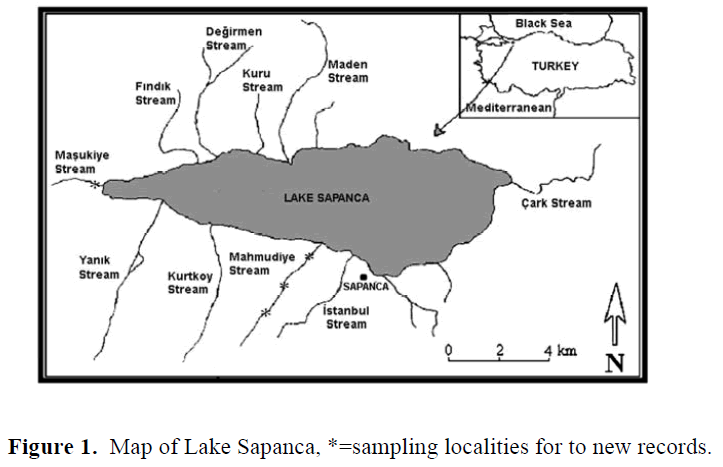
Figure 1. Map of Lake Sapanca, *=sampling localities for to new records.
The specimens examined in present study were collected by electroshocker and gill nets from Ma?ukiye and Mahmudiye streams.
We have chosen two or three different sampling stations on the streams based on their physical properties (i.e. stone or sandy, high or low velocity, slope situation). The samples were fixed and preserved in a 5% formaldehyde solution. Meristic counts and mensural measurements were made on the left side of each specimen.
Measurements were made with dial caliper and recorded to 0.1 mm. Meristic counts were made under a binocular dissection microscope. Standard length (SL) was measured from the tip of upper lip to the end of hypural complex (this procedure was also followed for G. holbrooki which has dorsal shape mouth, i.e. lower lip is longer than upper lip). The length of the caudal peduncle was measured from behind the base of the last anal-fin ray to the end of hypural complex, at mid-height of caudal- fin base. Gill rakers were counted on the anterior gill arch. The last two branched rays articulating on a single pterygiophore in the dorsal and anal fins are noted as "1½". Many different sources (Berg, 1949a, 1949b; Banarescu, 1964; Rauchenberger, 1989) were used for definition and determination of the genera and species of the fish samples. Species names were attributed according to Eschmeyer (1998). The specimens have been deposited in the collection of Istanbul University, Faculty of Fisheries, Department of Freshwater Biology and Istanbul University Science Faculty Hydrobiology Museum (IUSHM).
Results and Discussion
We found two new fish species from two streams which flow into the Lake Sapanca namely; P. phoxinus, and G. holbrooki. P. phoxinus was captured from Mahmudiye stream in 14 July 2006 while G. holbrooki from Ma?ukiye stream in 02 June 2006. Studies on the fish fauna in Lake Sapanca done by different researchers were tabulated in Table 1. Fish species reported in the present study were not previously recorded from Lake Sapanca Basin, and thus constitutes new records.
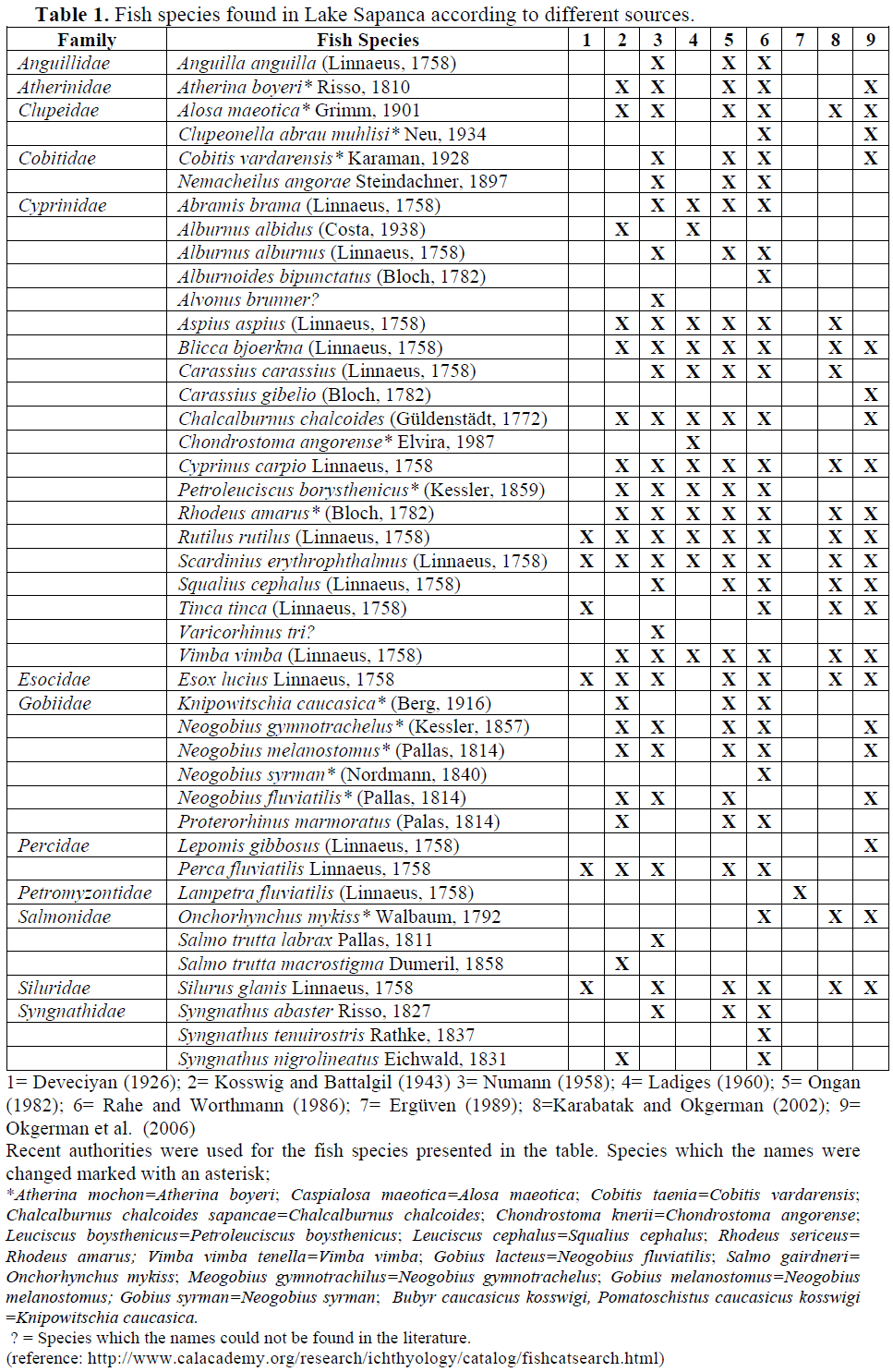
Table 1. Fish species found in Lake Sapanca according to different sources.
The individuals had all the distinguishing features of the species, including metric and meristic characters that agree with those reported for the species. See Figures 2-4 for general appearances and Table 2 for morphometric data of two new species recorded for the first time in the present study. Some of their diagnostic features are as following;
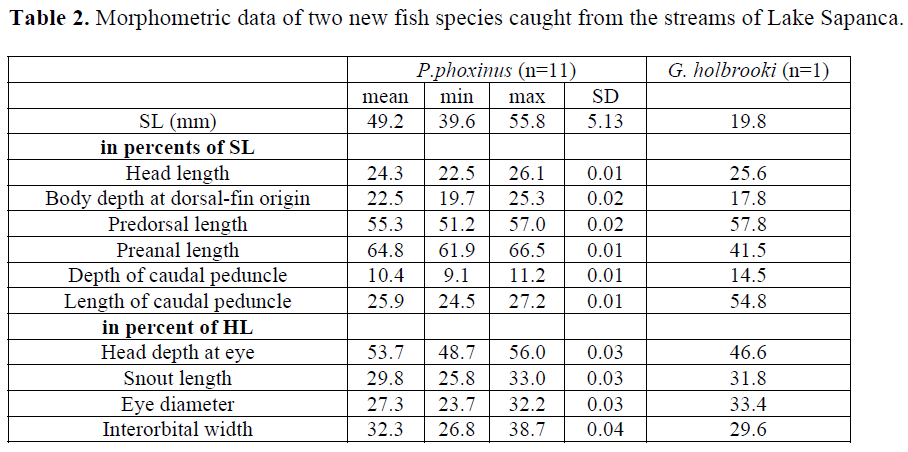
Table 2. Morphometric data of two new fish species caught from the streams of Lake Sapanca.
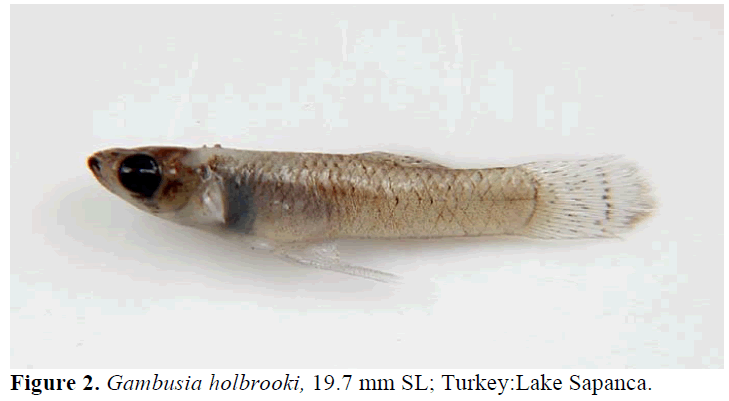
Figure 2. Gambusia holbrooki, 19.7 mm SL; Turkey:Lake Sapanca.
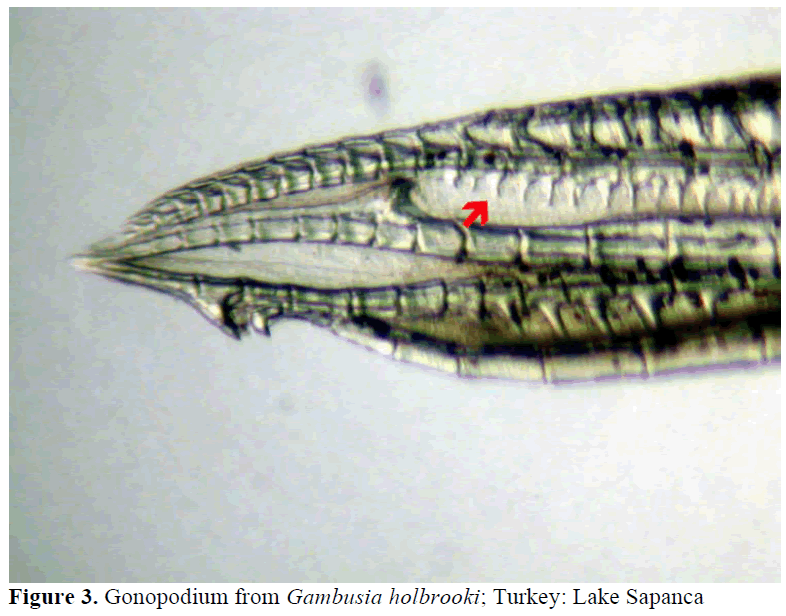
Figure 3. Gonopodium from Gambusia holbrooki; Turkey: Lake Sapanca
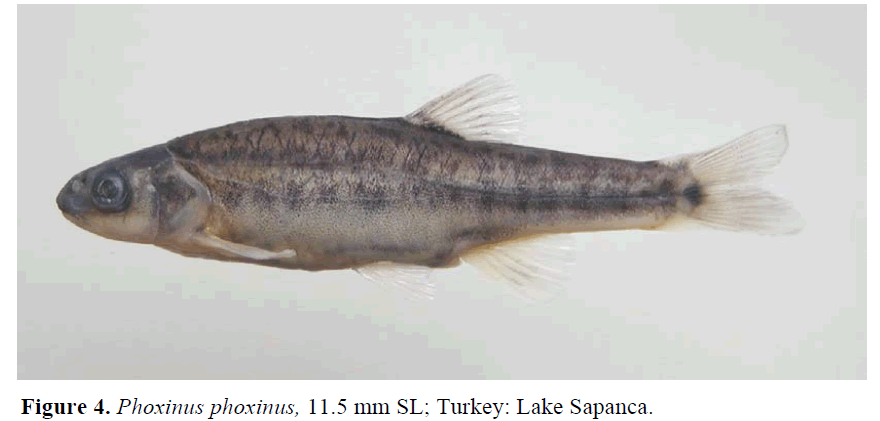
Figure 4. Phoxinus phoxinus, 11.5 mm SL; Turkey: Lake Sapanca.
Phoxinus phoxinus (Linnaeus, 1758)
Material examined: 14 July 2006, 11 specimens, Length: 39.6-55.8 mm SL
Diagnostic characteristics: Body elongate. Mouth small and subterminal. Upper jaw is a little longer than lower jaw. Head length longer than body depth. Dorsal and anal fins are slightly rounded. Caudal peduncle is long. 10 gill rakers on the first branchial arch; pharyngeal teeth 5.1-1.5, dorsal fin rays III 71½; anal fin rays III 71½; pelvic fin rays I 13-15; ventral fin rays II 7. Colour: Body greenish, speckles on whole body, randomly distributed black dots on flanks, belly light-yellow.
Ecology and Distribution: Lives in cold, running or still, yet well oxygenated waters over gravel substrate. Feeds on algae, plant debris, mollusks, crustaceans and insects. Spawning period is between May and June and reaches mature size at 2 or 3 years. Its distribution range is Eastern Europe and Northern Asia (Geldiay and Bal?k, 1996).
Gambusia holbrooki Girard, 1859
Material examined: 02 June 2006, 1 specimen, Length: 19.8 mm SL
Diagnostic characteristics: Small fishes. Scales are large. Mouth is large and lower jaw is prominent. Eyes are large. Dorsal fin rays II 6; posterior edge of the joins of the first elongate anal fin ray in the males distinctly serrated (Figure 3); lateral line scales 32. Colour: Body light grayish-brown; small speckles on body, dorsal and anal fins.
Ecology and Distribution: Inhabits warm, still waters typically seen shoaling at the edges of the streams and lakes (Allen et al., 2002). Feeds on small terrestrial insects usually in the drift and amongst aquatic plants, actively selecting very small prey (Arthington, 1989). Feeds also on mosquito larvae (Rupp, 1997). Native range probably was the Atlantic Coastal Plain from the Delaware River drainage south through Florida, and the Gulf Coastal Plain of Florida and perhaps to western Alabama (Wooten et al., 1988; Rauchenberger, 1989).
Two fish species reported in the present study were caught from the streams which flow into the Lake Sapanca. In Turkey, P. phoxinus is known from Thrace region and Anatolia (Polonezköy, Sakarya Basin and northeast Black Sea region (Geldiay and Bal?k, 1996). We found this species in quite big numbers in all zones along the Mahmudiye stream. This finding would suggest that there is a habitat overlap between Salmo trutta macrostigma (Dumeril 1858) and P. phoxinus in the stream. However, we do not know that occurrence of P. phoxinus population has consumed eggs of naturally isolated S. t. macrostigma and destructive effect on the population of this species. Further studies are certainly needed to better understand interactions between these co-occurring fish species in the stream.
Gambusia species prefer slow flowing waters and high vegetation (Rupp, 1997). Indeed, we caught one specimen in mouth of Ma?ukiye stream which had almost stagnant water on that time (02 June 2006). In Turkey, even though there have been many reports on G. affinis, only recent studies (Kuru, 2004; Özulu? et al., 2005a and 2005b; Tarkan et al., 2006) reported presence of G. holbrooki. This species separated from G. affinis with the posterior edge of the joints of the first elongate anal fin rays in the males was distinctly serrated as proposed by Berg (1949b) and Rauchenberger (1989). These teeth are absent in G. affinis. Tortonose (1970) and Spillmann (1961) also described this species-specific characteristic. This feature which distinguishes G. holbrooki from G. affinis was only mentioned in Özulu? et al. (2005a). This fact suggests that G. holbrooki might have been wrongly identified as G. affinis so far. For this reason, a comprehensive taxonomic revision is quite necessary for Gambusia species living in Turkish waters.
We presume that P. phoxinus and G. holbrooki have not been found so far due to absence of detailed study in the streams of Lake Sapanca. Some researchers caught several fish species from the streams based on few surveys. For instance; Ergüven (1989) recorded Lampetra fluviatilis (Linnaeus, 1758) from Yan?k and Kurtköy streams. We found one larval specimen of a Lampetra species from Yan?k stream during our fish surveys in the streams last year. However, we could not identify it as our sample was not adult individual which is necessary for definite identification. Kux and Steiner (1972) reported only Lampetra lanceolata for the first time from Black Sea coast of Turkey. However, L. fluviatilis has never been reported from Black Sea coast and Turkey with exception of Ergüven (1989). It has mostly been cited in Europe (coastal waters and rivers of north-western Mediterranean Sea, along European Atlantic coast, North Sea and the whole of Baltic Sea) (Vladykov, 1984). This fact indicates that more detailed studies are needed regarding identification of Lampetra species in Lake Sapanca and Turkey as well.
Conclusion
To date, although many reports have been given on the fish fauna of the Lake Sapanca, new fish species still appear from the lake and its inlets and outlets. Especially, there seems to be a big gap on the fishes inhabiting in the streams of the lake. This suggests that fish fauna of Lake Sapanca Basin should be extensively studied in detail to determine latest situation.
Acknowledgments
We are deeply indebted to Adnan Sümer, Güne? Emir, Murat Aliefendio?lu, Pelin Saliha Çiftçi for their help in sample collection in the field.
1743
References
- Albay, M., Akçaalan, R., Tüfekçi, H., Metcalf, S.J., Beattie, A.K and Codd, A.G., (2003). Depth profiles of cyanobacterial hepatotoxins (microcystins) in three Turkish freshwater lakes. Hydrobiologia 505: 89- 95.
- Allen, G.R., Midgley, S.H and Allen, M., (2002). Field guide to the freshwater fishes of Australia. Western Australian Museum, Perth, Western Australia. 394 p.
- Arthington, A.H., (1989). Diet of Gambusia affinis holbrooki, Xiphophorus helleri, X. maculatus, and Poecilia reticulata (Pisces: Poeciliidae) in streams of southeastern Queensland, Australia. Asian Fisheries Science 2:193-212.
- Banarescu, P., (1964). Fauna Republicii Populare Romine, Pisces-Osteichthyes, Vol. XIII, Bucuresti.
- Berg, L.S., (1949a). Freshwater Fishes of the U.S.S.R. and Adjacent Cuntries. 2, Israel Program for Scientific Translations 1964 (Translated from Russian), Jerusalem.
- Berg, L.S., (1949b). Freshwater Fishes of the U.S.S.R. and Adjacent Cuntries. 3, Israel Program for Scientific Translations 1964 (Translated from Russian), Jerusalem.
- Deveciyan, K., (1926). Türkiye’de Balık ve Balıkçılık. Aras Yayıncılık 2006 (Fransızca’dan çeviri), İstanbul.
- Ergüven, H., (1989). Sapanca Gölü’ne Dökülen Derelerde Yaşayan Petromyzonidae Familyasının Paraziter Türünün Saptanması Üzerinde Bir Araştırma. İ.Ü. Su Ürünleri Dergisi. 3: 29-36.
- Eschmeyer, W. N., (1998). Catalog of Fishes on-line, updated April 17, 2006. database, Avaible from: https://www.calacademy.org/research/icht hyology/catalog/fishcatsearch.html (April 20, 2006).
- Geldiay, R. and Balık, S., (1996). Türkiye Tatlısu Balıkları. Ege Üniversitesi Basımevi, İzmir.
- İnnal, D. and Erk’akan, F. (2006). Effects of exotic and translocated fish species in the inland waters of Turkey. Reviews in Fish Biology and Fisheries. 16: 39-50.
- Karabatak, M. and Okgerman, H., (2002). Sapanca Gölü Ekonomik Balık Türlerinin Kompozisyonu, Populasyon Bolluğu ve Boy Dağılımları Üzerine Bir Ön Çalışma. İ.Ü. Su Ürünleri Dergisi. 13: 81-98.
- Kosswig, C. and Battalgil, F., (1943). Türkiye tatlı su balıklarının zoogeografik ehemmiyeti. Türk Fiziki Tabii İlimler sosyetesi yıllık bildiriler arşivi II, sayı 8, 18-31.
- Kosswig, C., (1952). Die Anatolischen Seen und Ihre Fishereiliche Bewirtschattung. Zeitschrift für Fischerei und Desen Hilfwissenschaften, Hef t 8-10.
- Kuru, M., (2004). Türkiye içsu balıklarının son sistematik durumu. Gazi Eğitim Fakültesi Dergisi. 3: 1-21.
- Kux, Z. and Steiner, H. M., (1972). Lampetra lanceolata eine neue Neunaugenart aus dem Einzugsgebiet des Schwarzen Meeres in der nordöstlichen Türkei. Casopis Moravskeho Musea Acta Musei Moraviae 375-384.
- Ladiges, W., (1960). Süsswasserfische der Türkei, 1. Teil: Cyprinidae Mitteilungen aus dem Hamburgischen Zoologischen Museum und Institut. 58: 105-150
- Numann, W., (1958). Anadolu’nun Muhtelif Göllerinde Limnolojik ve Balıkçılık İlmi Bakımından Araştırmalar ve Bu göllerde Yaşayan Sazanlar Hakkında Özel bir Etüd. İstanbul Üniversitesi Fen Fakültesi Hidrobiyoloji Araştırma Enstitüsü Yayınlarından, Monografi, 7, 114 sayfa.
- Okgerman, H., Elp, M., Dorak, Z., Yardımcı, H.C., Yılmaz, N. and Yiğit, S., (2006). Sapanca Gölü’nün Balık Faunasındaki Değişimler. II. Ulusal Limnoloji Çalıştayı, OMÜ Sinop Su Ürünleri Fakültesi, Sinop, 6-8 Eylül 2006.
- Ongan, T., (1982). Güney Marmara Bölgesi İçsu Ürünlerini Geliştirme ve Su Kaynaklarının Envanteri Projesi. Sapanca. Özuluğ, M., Altun, Ö. and Meriç, N., (2005a). On the fish fauna of Lake İznik (Turkey). Turkish Journal of Zoology 29: 371-375.
- Özuluğ, M., Acıpınar, H., Gaygusuz, Ö., Gürsoy, Ç. and Tarkan, A. S., (2005b). Effects of human factor on the fish fauna in a drinking-water resource (Ömerli Dam Lake-Istanbul, Turkey). Research Journal of Agriculture and Biological Sciences 1: 50-55.
- Öztürk, S. and İkiz, R., (2004). Some biological properties of mosquitofish populations (Gambusia affinis) living in inland waters of the western Mediterranean Region of Turkey. Turkish Journal of Veterinary and Animal Sciences. 28: 355- 361.
- Rahe, R. and Worthmann, H., (1986). Marmara Bölgesi İçSu Ürünlerini Geliştirme Projesi. Sonuç Raporu. PN 78.2032.7. Eschborn. 146 sayfa
- Rupp, H. R., (1997). Mosquito control with Gambusia affinis. Journal of the American Mosqutio Control Association. 13: 296.
- Rauchenberger, M., (1989). Systematics and biogeography of the genus Gambusia (Cyprinodontiformes: Poeciliidae). American Museum Novitates. 2915: 1-74.
- Spillmann, C.J., (1961). Fauna de France, Poissons d’eau douce. 65, Editions Paul Lechevalier, Paris.
- Tarkan, A.S., Gaygusu, Ö., Acıpınar, H., Gürsoy, Ç., and Özuluğ, M., (2006). Length-weight relationship of fishes from the Marmara region (NW-Turkey). Journal of Applied Ichthyology. 22: 271-273.
- Tortonose, E., (1970). Osteichthyes (Pesci Ossei) Parte Prima, Fauna d’Italia, 10. Office Grafische Calderini, Bologna.
- Vladykov, V.D., (1984). Petromyzonidae. p. 64-67. In P.J.P. Whitehead, M.-L. Bauchot, J.-C. Hureau, J. Nielsen, and E. Tortonese (eds.) Fishes of the northeastern Atlantic and Mediterranean. UNESCO, Paris. vol. 1.
- Wooten, M. C., Scribner, K. T. and Smith, M. H., (1988). Genetic variability and systematics of Gambusia in the southeastern United States. Copeia 1988: 283- 289.












